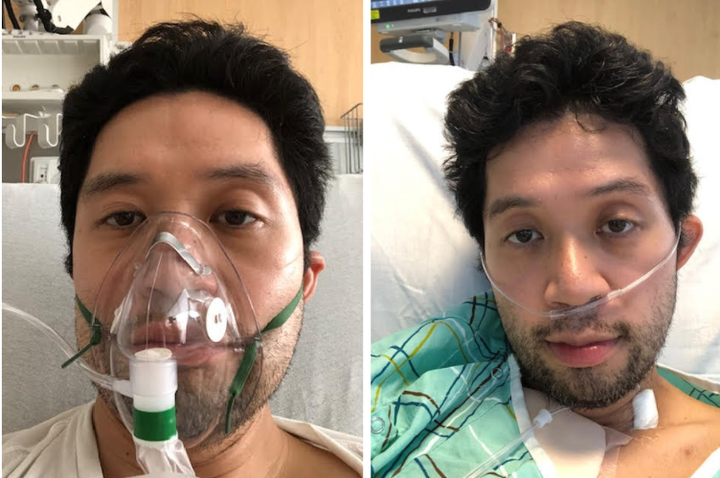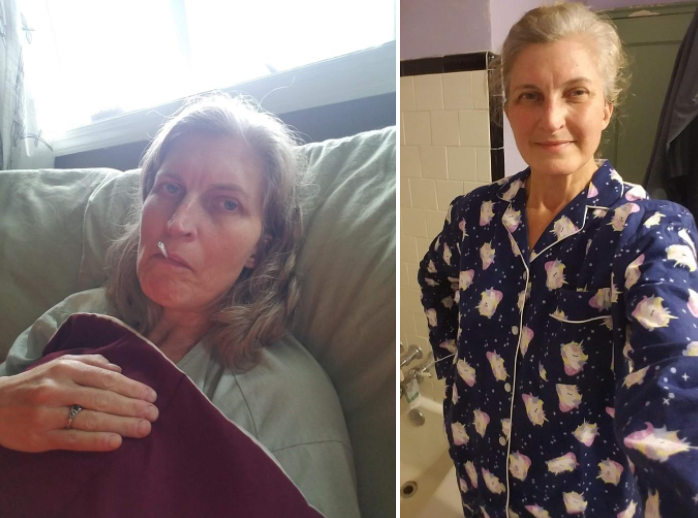
There have now been more than 7.5 million cases of COVID-19 in the U.S. since the first known cases emerged earlier this year. But not even nine months later, some of the first victims have yet to fully recover from what is now known as long or long-haul COVID.
A report released in July found that about 35% of people surveyed after being treated for the coronavirus at 14 U.S. hospitals had not fully recovered within two to three weeks of testing positive for the virus, which is the typical timeline given for recovery.
Studies elsewhere in the world have reported similar findings, with one conducted in China finding that 70% of people recovering from COVID-19 continued to have abnormal lung scans ― an indication that the lungs remain damaged and trying to heal ― three months after they left a hospital for treatment.
Other organs like the heart and brain have also been found to be at an increased risk of damage from COVID-19, which can lead to long-term health problems, according to the Mayo Clinic.
“You start to feel kind of lonely, like, is it just me? Am I going crazy?” COVID long-hauler Laura Long, 32, told HuffPost of the first few months of her illness, which began when long COVID was not known to exist.
Fortunately for her and many others, long COVID survivors have been able to find each other on social media and share their symptoms and recovery times, giving one another hope and companionship during an otherwise extremely dark time.
Here are some of their personal stories.
David Lat, 45, New York

It’s been seven months since Lat was hospitalized in New York City for the virus. His lungs remain damaged. Doctors don’t know if they’ll fully recover.
In roughly one week’s time, what started as fatigue, fever and body aches led to a 17-day hospital stay for Lat, a former lawyer turned legal writer. He spent six of those days on a ventilator.
“When I first got home from the hospital, I could barely walk; I had to use a wheelchair if I wanted to go around the block,” he said. “I feel much better now, but for about three months, I had a terrible cough ― it would keep me up at night and make my whole upper body hurt ― and shortness of breath.”
The cough and shortness of breath lasted for about three months, he said. It’s now been seven months since he was hospitalized, but he has yet to fully recover.
Today:
Before COVID-19, Lat said he was physically active and could run for miles without issue. Though he had asthma as a child, he can’t remember the last time he had an asthma attack. Today, post-COVID, Lat has been advised to use a daily “maintenance” inhaler and to be careful while physically exerting himself.
“I still have some scarring on my lungs, and I can’t exercise like I used to. Before COVID, I could run for miles. Earlier [in September], I finally got to the point where I could run one mile without stopping,” he said.
Lat said his pulmonologist considers him lucky.
“He’s seen COVID patients who are much worse off, including some who need lung transplants. My lungs have improved a lot since my hospitalization in March, but it’s not clear whether they will continue to get better or if this is how they’ll be for the rest of my life,” he said.
He has also faced mental health consequences from the virus, including depression and anxiety.
“I worried that I would never get better,” he said. “I feel much better today, but I still worry that I could get worse again. COVID is a new disease, and there’s so much we don’t know about it.”
Like others, he has detailed his journey on social media in hopes that it will educate others about this longer, monthslong recovery that many are facing.
Stephanie Joyner, 52, Maryland

Joyner, a high school teacher, went from healthy and athletic to fearing she was on her deathbed. Six months after contracting the virus, she’s just trying to maintain.
As a high school science teacher with a degree in biology, Joyner was well aware of how viruses spread and how to avoid catching them. So before her school went on lockdown due to the pandemic in March, she said, she spent the last 10 minutes of every class focusing on viruses with her students.
“I was just doing my best so they understood that taking these measures is a good thing,” she said of recommended safety precautions such as social distancing and wearing a mask.
The fact that she was aware of these precautions and carefully followed them herself was an extra blow when she fell ill in early April.
For Joyner, COVID-19 started with an extreme headache that lasted for several days. Then the “telltale symptoms” of the virus started, she said.
These included a dry cough, fever, and loss of taste and smell. Over the next several weeks, she had joint pain, skin bruising without injury, fever, fatigue, diarrhea, nausea, vomiting, insomnia, night sweats, perpetual thirst, brain fog, heart palpitations, and pain in her lymph nodes.
“They were so swollen, it felt like they were going to explode,” she said.

The virus also affected her menstrual cycle, she said. “I bled for two weeks straight and it was the kind of blood you have after having a baby,” she said, attributing this heavy flow to ruptured capillaries.
Joyner and her doctor counted 23 symptoms happening simultaneously at one point. Because tests for COVID-19 weren’t available from her doctor’s office at the time, she was clinically diagnosed as having the virus.
She credited friends and family for checking in on her remotely and making sure she was alive.
“I had weeks of that, where I was afraid I wasn’t going to wake up,” she said, her voice breaking.
She likened the virus’ complications to post-viral syndromes for other illnesses, such as Lyme disease, tuberculosis and Ebola.
“It’s well-documented,” she said. “So why nobody thought we would experience this, it just blows my mind.”
Joyner has joined several online survivor groups. Most of the members, she said, are in their 20s, 30s and 40s, with the older people facing higher morbidity from the virus.
In these groups, the members listen to one another and exchange advice, news developments, support and guidance as they wait for the science ― and in some cases, government officials ― to catch up.
“I had weeks of that, where I was afraid I wasn’t going to wake up.”
- Stephanie Joyner, 52
Today:
Four months after her recovery started, Joyner says she continues to have flare-ups but that they’re far less common than they were and require far less time to recover.
She lost 50% of her lung capacity at the start of her illness but has since regained 10%. Her resting heart rate remains higher than usual, rarely going below 80, which she called an improvement. She also remains sensitive to particularly warm or cold temperatures and cannot go outside without wearing a brimmed hat and sunglasses due to photosensitivity issues with her eyes.
There have also been lasting mental health effects, particularly anxiety and fear that she could contract the virus again while in her weakened state.
“I rarely go out,” she said. “I am so scared of getting sick again, and that’s just not me. I’ve never been the person to worry like, ‘What if?’”
“I was so careful, and I got sick,” she said. “I feel like it’s going to get me again.”
She also feels anger and disbelief about the situation her country is in and how it’s responding, particularly when it comes to mask-wearing and the limited time some survivors have before they have to go back to work.
“They don’t give a damn if we live or die. All they care about is their bottom line,” she said. “Here in the U.S., we’ve normalized mass death, which is just mind-boggling.”
Laura Long, 32, Nevada

Long, a mother of two young boys, continues to have heart palpitations and fatigue eight months since contracting the coronavirus.
Long considered herself to be “in perfect health” when she contracted the virus sometime early this year. It’s been about eight months since then, and she’s still trying to get her life back.
“Chills, very tired, it felt like it took effort for my body to just lie on my bed,” she said of her initial symptoms, which began on March 14. This was after both of her children and their classmates came down with a strange cough that lasted for weeks.
Long received a 10-day prescription of prednisone in hopes that the steroid would snuff out her symptoms early. Instead, she says, she got worse.
“I got very nauseous, I couldn’t talk, I would dry heave if I talked too much. I started to get hallucinations,” she said. “It wasn’t like I was seeing anyone from my past that was dead, it just felt like it was any typical sci-fi movie where a bug invades you, and I felt like the virus was inside me and talking to me like, ‘I’m in here. I’m in charge.’”
“I got very nauseous, I couldn’t talk, I would dry heave if I talked too much. I started to get hallucinations.”
- Laura Long, 32
In addition to the hallucinations, Long’s heart rate, which she measured with her Apple smartwatch, was unpredictable. She’d be lying in bed and record it suddenly go from 60 beats per minute to 100. Her doctor clinically diagnosed her with the virus since she wasn’t able to get tested.
“That was the first time in my life where I thought I was going to die,” she said.
The mental anguish was perhaps the hardest, Long said.
“No one knew anything. You couldn’t get a test,” she said. “Being on a ventilator sounded super scary, and then you hear people protest because they can’t get a haircut.”
Around the fourth week, she said, she finally began to “feel human again” and was able to leave her self-quarantine.
Today:
Long’s physical stamina has improved and she’s able to push herself a bit more physically, but she describes everything as “a cycle” in which all the symptoms come back, only for shorter periods of time.
Doctors have not found anything wrong with Long, and an annual physical in July determined that her heart and lungs are healthier than they were a year prior.
Her youngest son, 3, has had a reoccurring rash that first appeared when he had his cough. Her oldest, 8, has complained of having heart palpitations while doing sedentary activities.
Long also continues to have heart palpitations and exhaustion. On top of this, she has anxiety. She fears she could contract the virus again.
“It did all this to me and I was in the best shape of my life. Imagine if I got it again, what would happen in my condition,” she said.
Long hopes that publicly sharing her experience helps others.
“There are people who still say that COVID is a hoax and ‘long COVID’ is a hoax and it’s a conspiracy to keep us all afraid,” she said.
“You feel a little bit hopeless,” she said of how that makes her feel. “If people are going to deny that the problem exists, then you’re more steps away from a solution.”
Jillian Reed, 48, Connecticut
Nearly seven months after contracting the virus, Reed, a mother of two, remains on bed rest and unable to work. Doctors have not been able to determine what’s wrong.
Reed was preparing to have brain surgery at a Pennsylvania hospital to deal with hemifacial spasms when she suspects she contracted the coronavirus. If her doctor hadn’t postponed the surgery due to concerns about the virus’ spread, she has doubts that she’d be alive today.
“We were very cautious and careful because we knew the risks,” she said of her and her husband’s efforts to social distance ahead of her surgery. The one thing no one was doing, however, was wearing masks. That’s because health officials at the time were telling people without coronavirus symptoms not to. Experts now acknowledge that the virus can go airborne.
“I was in five different locations of this hospital and there was no mask mandate. That was March 19,” she said — the exact date the president had told journalist Bob Woodward that he knew the virus could spread through the air.
Roughly four days after her surgery was canceled, Reed said she started coughing and experiencing shortness of breath. Thus began the “eight weeks of the elephant sitting on my chest,” she said.
“I couldn’t talk. The cough would not stop. I couldn’t sleep. I have a CPAP machine from before that I think saved me,” she said, describing the air pressure device used for sleep apnea.
In addition to going to the emergency room twice when she was unable to breathe, Reed said she has suffered fainting spells, low blood pressure, inflammation, painful headaches and brain fog that has left her unable to work. Like other COVID-19 survivors, she’s also experienced hallucinations, depression and anxiety.
“Jesus and I have had several discussions where I tell him, we’re at the binary decision point now, either he brings me up to heaven and I start hanging out with him or he starts healing me. Because I can’t take the pain anymore,” she said, her voice breaking. “And there were a lot of nights where I was just too afraid to sleep because I was certain that I was not going to wake up.”
She credited her husband and youngest daughter, who is home taking a gap year, for not just supporting and comforting her but literally keeping her alive.
“They’ve been my rock,” she said.
“Just seeing people without their masks, it’s just like, oh my God, you have no idea.”
- Jillian Reed, 48
Today:
It’s been nearly seven months since Reed contracted the virus, but not much appears to have changed. She is on bed rest and unable to work. At no point, she said, has she not experienced a fever, coughing, or neurological issues. She’s had multiple tests and scans but said that her doctors have not been able to determine what’s wrong.
“Everything comes out normal. They can’t seem to pinpoint it,” she said.
Her bloodwork is the one thing that is far from normal, she said, but doctors have been at a loss to know why. She’s had to take blood thinners, is now on thyroid medication, and also extra vitamin D due to low levels, she said.
She’s also taking medical marijuana and CBD, which she called “a lifesaver” in helping minimize her pain and inflammation.
Like other survivors, she’s also been dealing with heavy emotional issues, including anger and anxiety over those who don’t wear masks.
“Just seeing people without their masks, it’s just like, oh my God, you have no idea,” she said. “I definitely think I’ll have [post traumatic stress disorder] for a while because of that. It’s going to be hard to get back to going out into the public.”
She called the online support groups for fellow COVID long-haulers a tremendous help. Other survivors have made her feel less alone, even in physical isolation.
Perhaps the one positive out of all of this is that Reed hasn’t had to go back and have brain surgery. Her neurologist said that inflammation related to the coronavirus had probably moved a blood vessel off of a nerve and stopped the hemifacial spasms she’d been experiencing.
“I’ll take that happy little accident,” she said of her improvement.
